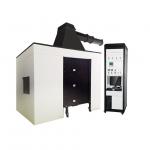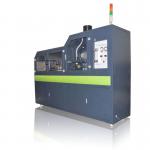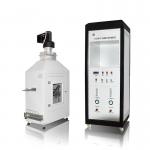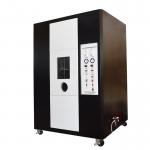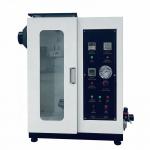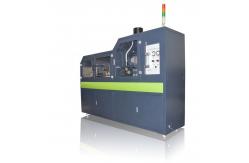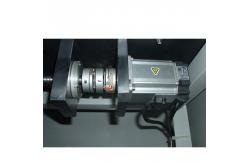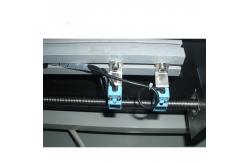In the realm of material safety assessment, understanding the
toxicity of smoke generated during combustion is of utmost
importance. The Material Smoke Toxicity Hazard Classification
Tester Steady State Tube Furnace emerges as a crucial instrument
for precisely evaluating the potential hazards associated with the
smoke produced by various materials. The Material Smoke Toxicity Hazard Classification Tester Steady
State Tube Furnace is a specialized device designed to classify the
smoke toxicity hazard of materials. It is used in a wide range of
industries, including building materials, plastics, textiles, and
electronics, to determine the toxicity levels of smoke emitted when
these materials are subjected to combustion. By simulating a
steady-state burning process in a controlled tube furnace
environment, it measures the concentration of toxic gases and
particulates in the smoke, providing essential data for assessing
the potential harm to human health and the environment. This
information is vital for ensuring compliance with safety
regulations and for making informed decisions about material
selection and usage. - Robust and Heat-Resistant Construction
- The tester is constructed from high-quality heat-resistant alloys
and stainless steel, ensuring durability and the ability to
withstand the extreme temperatures and corrosive gases generated
during the testing process. The tube furnace is carefully
engineered to provide a stable and uniform heat distribution,
allowing for accurate and reproducible results. The interior
surfaces are designed to minimize adsorption and reaction with the
smoke components, ensuring the integrity of the test data.
- The heating element of the tube furnace is a precision component,
capable of maintaining a constant and adjustable temperature over
an extended period. It is designed to reach and sustain the
required temperatures for different test standards and materials,
with minimal temperature fluctuations. The insulation surrounding
the furnace is highly efficient, reducing heat loss and maintaining
a stable thermal environment.
- Precision Instrumentation and Measurement Capabilities
- Equipped with state-of-the-art gas sensors and a sophisticated data
acquisition system, the tester can accurately measure the
concentration of a wide range of toxic gases, such as carbon
monoxide, hydrogen cyanide, sulfur dioxide, and nitrogen oxides.
These sensors have high sensitivity and selectivity, enabling the
detection of even trace amounts of toxic substances. The data
acquisition system records all test data in real-time, including
temperature, gas concentrations, and time, and stores it in a
format that is easily analyzable.
- The user interface is intuitive and user-friendly, allowing
operators to easily set test parameters such as temperature, gas
flow rate, and sample size. The tester can generate detailed
reports, complete with graphs and charts, that vividly illustrate
the toxicity characteristics of the smoke generated by the tested
material. It also has built-in calibration functions to ensure the
accuracy of the measurements over time.
- Flexible and Adjustable Test Setup
- The Material Smoke Toxicity Hazard Classification Tester offers a
high degree of flexibility in accommodating different sample types
and sizes. The sample holder is adjustable and can securely grip a
wide variety of materials, from powders and granules to solid
samples and fabrics. The ventilation system of the tester is also
adjustable, allowing for the control of gas flow and the simulation
of different combustion conditions. This is crucial as air supply
and flow rate can significantly affect the composition and toxicity
of the smoke, and the ability to manipulate these factors provides
more accurate and relevant test results.
- It is designed to perform a multitude of test methods and
standards, making it suitable for both routine quality control
testing and in-depth research and development activities. Whether
adhering to international standards like ISO 19700 or
industry-specific regulations, the tester can be easily configured
to meet the specific requirements of any testing scenario.
- Specifications
| Power supply voltage | AC220V±10%, 50HZ, current ≤ 10A | | Maximum power | 2 KW | | Maximum heating power | 1200 W | | Temperature control range | 300℃ ~ 1000℃ | | Control accuracy | Static ±1℃ | | Air flow | 0~25 L/min adjustable | | Ring furnace displacement rate | (10±0.1) mm/min | | Air source | Dry, clean compressed air, 2-8kg/cm2 | | Microcomputer control | Computer operation | | Ring furnace heating temperature calibration | Display time, temperature curve and actual measured temperature
comparison chart | | Graph | Showing the angular velocity of the squirrel cage in real time | | Maximum stroke of the ring furnace | > 600 mm | | Function | With manual, automatic ring furnace fast forward and retreat
function | | Test chamber size | L2400 x W680 x H1730 mm |
- Accurate Smoke Toxicity Evaluation
- The primary function of the tester is to provide a detailed and
accurate assessment of the smoke toxicity of materials. By
measuring the concentration of toxic gases and particulates, it
determines the potential harm that the smoke can cause to human
health. A higher concentration of toxic substances indicates a
greater hazard, which is crucial information for industries where
fire and smoke exposure are potential risks. For example, in the
building materials industry, knowing the smoke toxicity of
insulation materials or wall coverings can help architects and
builders select safer options for occupant protection.
- The measurement of the rate of smoke toxicity generation is also
important. It helps in understanding how quickly the toxic
components build up during a fire, which is essential for designing
effective ventilation and protection systems. Materials that
produce toxic smoke at a slower rate may give more time for
evacuation and the implementation of safety measures.
- Hazard Classification and Safety Compliance
- The data obtained from the tester is used to classify the smoke
toxicity hazard of materials according to established standards.
This classification helps in categorizing materials based on their
potential risk levels, enabling manufacturers and regulators to
make informed decisions about their use and handling. For instance,
in the transportation and storage of hazardous materials, proper
hazard classification is essential for ensuring compliance with
safety regulations and for implementing appropriate safety
precautions.
- The tester also aids in ensuring compliance with safety standards
and regulations. Regulatory bodies rely on accurate smoke toxicity
test results to enforce safety requirements and protect the public
from the potential dangers of toxic smoke. Manufacturers can use
the tester to conduct tests in accordance with relevant standards,
demonstrating that their products meet the necessary safety
benchmarks.
- Research and Development Support
- In the field of material science and engineering, the tester is an
invaluable asset. It allows researchers to study the smoke toxicity
characteristics of new and innovative materials. For example, in
the development of flame-retardant or environmentally friendly
materials, the tester can be used to evaluate the impact of
different additives and formulations on smoke toxicity.
- By understanding how different factors influence smoke toxicity,
researchers can optimize the design and composition of materials to
reduce their potential harm. This could involve the addition of
smoke suppressants, the modification of polymer structures, or the
development of new manufacturing processes. The detailed data
provided by the tester serves as a roadmap for driving innovation
and improving the overall safety of materials.
- Stringent Manufacturing Process
- The Material Smoke Toxicity Hazard Classification Tester Steady
State Tube Furnace is manufactured under strict quality control
procedures. Each component is carefully sourced and inspected for
quality and performance. The assembly process is carried out by
highly trained technicians in a clean and controlled environment,
ensuring the proper alignment and functionality of all parts.
- The calibration of the heating element, gas sensors, and
measurement systems is a critical and regular part of the
manufacturing process. It is performed using traceable reference
standards to guarantee the accuracy and reproducibility of the test
results. Rigorous quality audits and inspections are conducted at
various stages of production to maintain the highest level of
product quality.
- Quality Certification and Validation
Our tester has obtained relevant quality certifications and has
been validated by independent testing laboratories. It has been
proven to provide accurate and reliable test results, conforming to
the most demanding international and national safety standards for
smoke toxicity testing. We also continuously update and improve our
product based on the latest technological advancements and customer
feedback to ensure its long-term performance and compliance.
- Building Materials Industry
- A leading manufacturer of insulation materials used the Material
Smoke Toxicity Hazard Classification Tester to evaluate a new
product line. The test results showed that the new insulation had
significantly lower smoke toxicity compared to their previous
models. This enabled them to market the product as a safer option,
meeting the increasing demand for environmentally friendly and
fire-safe building materials. The company experienced an increase
in sales and enhanced its reputation in the market.
- A wallboard producer utilized the tester to develop a
fire-resistant and low-smoke-toxicity wallboard. By testing
different formulations and additives, they were able to optimize
the product's performance. The resulting wallboard met the
strictest safety standards and was widely adopted in commercial and
residential construction projects, contributing to improved indoor
air quality and fire safety.
- Plastics and Textiles Sectors
- A plastics manufacturer used the tester to assess the smoke
toxicity of a new type of flame-retardant plastic. The data helped
them understand the effectiveness of the flame-retardant additives
in reducing smoke toxicity. The plastic was then used in the
production of consumer electronics housings, where fire safety and
low smoke toxicity are crucial. The product received positive
feedback from customers and regulatory bodies.
- A textile company employed the tester to study the smoke toxicity
of different fabric finishes. They were able to develop a new line
of fire-resistant and low-toxicity fabrics for use in upholstery
and protective clothing. The fabrics met the relevant safety
standards and gained a competitive edge in the market.
- Research Institutions
- A research institute focused on sustainable materials used the
tester to study the smoke toxicity of bio-based composites. The
data obtained helped them identify areas for improvement and
develop new formulations with reduced smoke toxicity. Their
research contributed to the advancement of sustainable and
fire-safe material technologies, with potential applications in
various industries.
- Pre-Sales Technical Consultation
Our team of experts provides in-depth technical consultations to
help customers understand the capabilities and suitability of the
Material Smoke Toxicity Hazard Classification Tester Steady State
Tube Furnace for their specific testing needs. We offer
demonstrations and training to familiarize customers with the
operation and functionality of the equipment before purchase. We
also assist in selecting the appropriate test methods and
accessories based on the materials and applications to be tested. - After-Sales Service and Maintenance
We offer comprehensive after-sales service, including on-site
installation and commissioning. Our technicians are available for
regular maintenance, calibration, and emergency repairs. We provide
spare parts and upgrades to keep the tester operating at peak
performance. We also offer service contracts that include
preventive maintenance and priority technical support, ensuring the
long-term reliability and availability of the equipment. - Training and Technical Support
We conduct training programs for new users to ensure they can
effectively operate the Material Smoke Toxicity Hazard
Classification Tester Steady State Tube Furnace and interpret the
test results. Our technical support team is available 24/7 to
answer questions, provide troubleshooting assistance, and offer
guidance on test method optimization and compliance with relevant
standards. We also provide software updates and support for the
data acquisition and analysis systems, enabling customers to take
full advantage of the latest features and technologies.
The Material Smoke Toxicity Hazard Classification Tester Steady
State Tube Furnace is an essential tool for ensuring the safety of
materials by accurately assessing their smoke toxicity. With its
advanced features, reliable performance, and comprehensive service
and support, it empowers industries to make informed decisions,
comply with regulations, and drive innovation in material
development. Invest in our tester and take a significant step
towards enhancing fire safety and environmental protection. |
